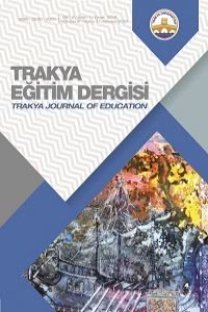An Analysis of Pre-service Primary Teachers’ Drawings of the Digestive System
Drawings, digestive system
___
- American Association for Advancement of Science (1993). Benchmarks for science literacy. New York: Oxford University Press. Cachapuz, A. F. C. & Maskill, R. (1987). Detecting changes with learning in the organization of knowledge: use of word association tests to follow the learning of collision theory. International Journal of Science Education, 9, 491–504. Cardak, O. (2015) Student science teachers’ ideas of the digestive system. Journal of Education and Training Studies, 3(5), 127-133. Cerrah Özsevgeç, L. (2007). What do Turkish students at different ages know about their internal body parts both visually and verbally. Journal of Turkish Science Education, 4(2), 31-44. Dempster, E. R. & Stears, M. (2014). An analysis of children's drawings of what they think is inside their bodies: A South African regional study. Journal of Biological Education, 48(2), 71-79. Driver, R. & Guesne, E. & Tiberghien, A. (1985). Children’s ideas in science. Milton Keynes: Open University Press. Driver, R. & Squires, A. & Rushworth, P., & Wood-Robinson V. (1994). Making Sense of Secondary Science, research into children's ideas. London and New York: Routhledge. Gellert, E. (1962). Children's conceptions of the content and functions of the human body. Genetic Psychology Monographs, 65, 293-405. National Research Council (1996). National science education standards. Washington: National Academy Press. Novak J. D. & Gowin D. B. (1984). Learning how to learn. New York: Cambridge University Press. Osborne, J. & Wadsworth, P., & Black, P. (1992). The Science processes and concept exploration (SPACE) research report: Processes of life. Liverpool: Liverpool University Press. Osborne, J. (1994). Young Children’s Understanding of Science in 4 Domains and Its Development Through A Constructivist Approach to Teaching. Ph.D Thesis. London University. London. Reiss, M. J. & Tunnicliffe, S. D. (2001). Students’ understandings of human organs and organ systems. Research in Science Education, 31, 383-399. Richardson, V. (Ed.) (1997). Constructivist Teacher Education. Building a World of New Understandings. London: The Falmer Press. Sasmaz-Oren, F. & Ormanci, U. (2014). Exploring pre-service teachers’ ideas about the digestive system by using the drawing method. Journal of Baltic Science Education, 13 (3), 316-326. Teixeira, F. M. (2000) What happens to the food we eat? Children’s conceptions of the structure and function of the digestive system. International Journal of Science Education, 22 (5), 507-520. Weiss, I. (1994). National survey of science and mathematics education. Research Triangle Park: Centre for Educational Research and Evaluation.
- ISSN: 2630-6301
- Yayın Aralığı: Yılda 3 Sayı
- Başlangıç: 2011
- Yayıncı: Trakya Üniversitesi Eğitim Fakültesi
Görme Yetersizliği Olan Öğrencilerin Öğrenmelerini Destekleyici İhtiyaçlar
Nazire Burçin HAMUTOĞLU, Mübin KIYICI
Sınıf Öğretmeni Adaylarının Uygulama Deneyimlerinin Mesleki Sosyalizasyon Süreci Olarak İncelenmesi
Turgay ÖNTAŞ, Taner ATMACA, Bengisu KAYA
Fen Bilgisi Öğretmen Adaylarının Sözde Bilimsel Senaryolarda Bilimin Doğasını Kullanımı
Bilişsel İşlevlerin Değerlendirilmesi Ölçeği Türkçe Uyarlaması ve Geçerlik-Güvenirlik Çalışması
Ezgi AKŞİN YAVUZ, Rengin ZEMBAT
Bilim Şenliğinin Öğretmen Adaylarının Fen Öğretimine ve Öğrencilerin Fene Yönelik Tutumlarına Etkisi
Hüsnüye DURMAZ, Emrah OGUZHAN DİNÇER, Aslıhan OSMANOĞLU
Sınıf Öğretmenlerinin Eğitsel Değerlendirme Sürecine İlişkin Görüşleri
Fen Bilimleri Eğitiminde Yapılmış Nitel Çalışmaların İçerik Analizi
